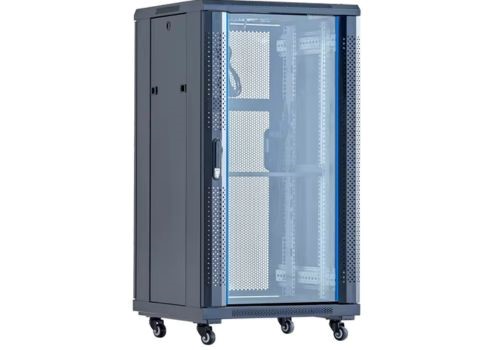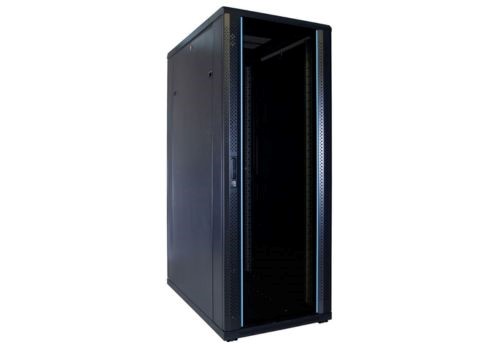When we talk about two important components of data centers or server room infrastructure we mainly think of ‘Server Racks’ and ‘Server Cabinets’.
Likewise, they both have similar function in the data centers but they are different from each other.
However, all the differences between server racks vs server cabinets are explained in this article, so continue reading to know their function, security and impact of environment.
Understanding Server Racks vs Cabinets

The server rack is a type of rack explicitly designed for arranging and storing information technology systems. Many processes require multiple pieces of equipment to perform their essential duties.
When servers and other IT equipment are stacked in a rack, airflow can be monitored and organized more efficiently.
On the other hand, the server cabinets are enclosed structures that provide superior security and protection for IT equipment. Cabinets generally have side panels that increase security and help keep equipment cool, as well as doors that can be secured to prevent unauthorized entry.

Server Rack vs. Server Cabinet: Comparative Analysis
Structural Differences
Server Rack: The open structure design vertically equipped with mounting rails makes it look and work effectively. Even though, it usually lacks side panels and doors but you can use it easily.
Server Cabinet: Likewise, a fully enclosed building with side panels, a roof, and lockable doors. Gives the equipment a controlled environment and greater security.
Design and Build
Server Rack: It is quite simpler structure allows for easier equipment access and installation. Usually cheaper and lighter in weight.
Server Cabinet: In the opposite end of the spectrum, this is a more complex design with features such as cable management, ventilation systems and sometimes doors.
Size and Dimensions
Your container will need to have the same size in both standard 19-inch height and width units, called rack units (U).
Server Cabinet: Standard heights (U), but deeper and wider than a server cabinet due to cable management and cooling. Combo based, and sizes may vary.
Functionality and Use Cases
Server Rack: The ideal design for this type of rack is the Server rack, that offers a comfortable access, and is perfect for IT Infra-structures that work in the right way or have the configuration of the computer room often changed
Server Cabinet: Despite this, the airflow is good and the price is reasonable. On the contrary, it is chosen in safe, controlled environments (where temperature limitations and sensitive data come into play). An excellent use for some hardware which needs a long running configuration.
Accessibility
Server Rack: grants full-side equipment access for support, redesign, and troubleshooting. An open design contributes to better cable management.
Server Cabinet: Doors must be opened and panels must be removed to access equipment. It can be tough to work with them as dealing with cables is a messy process because they are encased.
Cooling and Ventilation
Server Rack: The Server Rack uses ambient airflow to cool these servers when air conditioning is already available. Overheating occurs faster in hot weather than cooler temperatures.
Server Cabinet: In the meantime, an air conditioner or integrated fan can provide active cooling. Better suited for cooling hot air from high-density equipment.
Security
Server Rack: it offers minimal physical security from unintentional damage or criminal access. Despite this, vinyl is more prone to environmental pathogens and dust.
Server Cabinet: It with fully enclosed design with lock, additional security. Shields equipment from rough handling, contamination, and dirt.
Installation and Maintenance
Server Rack: (open format — reduces installation time) Reduces equipment weight so that tools are easier for transport for repairs But IT Requires Slightly More Setup.
Server Cabinet: the configuration is a little more advanced here because of the doors, panels, and the possibility of cooling. Panels or wires may need to be taken down by maintenance personnel to gain access.
Cost Considerations
Server Rack: They are generally more cost effective because their design is relatively straightforward, and this rack is made of wood.
Server Cabinet: It is important to understand that server cabinets can get quite expensive from the get-go with vent holes, doors, and panels. The right cooling system may offer long-term energy savings.
Ideal Environment to Use
Server Rack: These spacious, temperature-regulated compounds promote rapid growth and rapid retrieval (gravitational tug). Great for high-growth companies and an agile IT environment.
Server Cabinet: For server cabinets: a secure, regulated environment with extreme temperature ranges or has sensitive data. Perfect for high-density long-term deployments that need reliable cooling and security.
Is It Okay To Use Electrical Enclosures In Server Cabinets VS Server Racks?
No, server cabinets should not have electrical enclosures. They offer a fire risk due to the increased heat and potential for sparking. Furthermore, they obstruct airflow and occupy space that could be used for servers.
Difference b/w Server Rack and Server Cabinet – In a Nutshell
| Feature | Server Rack | Server Cabinet |
| Structural Differences | Open frame | Fully enclosed |
| Design and Build | Simpler, lighter | More complex, heavier |
| Size and Dimensions | Standard by U (height), width 19″, variable depth | Similar U height, wider, deeper |
| Functionality and Use Cases | Easy access, cost-effective, well-ventilated | Secure, controlled environment, strict temp |
| Accessibility | Easy access from all sides | Requires opening doors/panels |
| Cooling and Ventilation | Relies on ambient air | Active cooling (fans, AC) |
| Security | Lower physical protection | Enhanced security with lockable doors |
| Installation and Maintenance | Faster installation, easier maneuvering | More complex setup, potentially require removing panels/cables |
| Cost Considerations | More cost-effective | Higher upfront cost |
| Ideal Environment | Well-ventilated, climate-controlled rooms | Secure, controlled environments |
Conclusion
Finally, this is the end of our post, and now you can decide after knowing which server rack vs cabinet data to choose for your needs. After all these differences, both are useful for perfecting their places. However, whenever you want to buy any of them, always look for some factors such as their security and their impact on the environment. Server racks and cables are used in IT companies, and they maintain a large amount of data and keep it organized.




